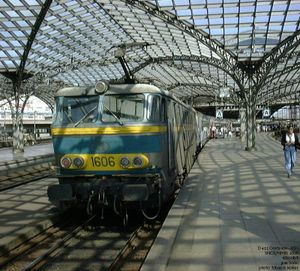| Class 16 | |||||||||||||||||||||
|---|---|---|---|---|---|---|---|---|---|---|---|---|---|---|---|---|---|---|---|---|---|
 NMBS/SNCB Class 16 loco 1606 at Köln Hbf | |||||||||||||||||||||
| |||||||||||||||||||||
| |||||||||||||||||||||
| |||||||||||||||||||||
| |||||||||||||||||||||
The class 16 locomotives were built to work cross border services from Belgium. They are equipped to run in France, Netherlands and Germany. They have been displaced from these workings by Thalys electric multiple units and ended up working a few peak hour commuter trains until 2007 when they were withdrawn with two of them saved for preservation. When built they were classified as type 160.